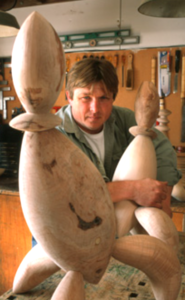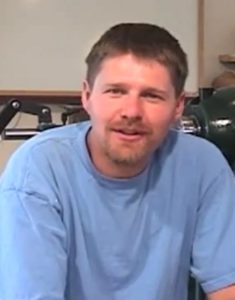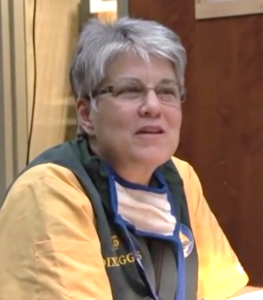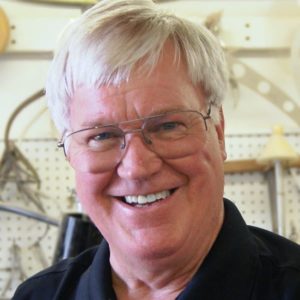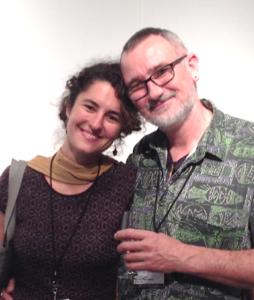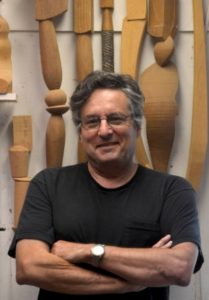2019 Demonstrators
Click here for the Rotation Schedule
[wptab name=’Mike Hosaluk’]
Mike Hosaluk |
| My love of woodworking is not only for the beauty and mystery of the material, but in the inventing of new techniques and processes to create objects.
The materials I use relate to the objects I make. At times a piece of salvaged wood will become a starting point of design. Other times, a design will call for a piece of wood with incredible grain. Using plain wood like birch allows me to approach the objects as a three dimensional canvas. Here, I can apply a variety of surface design techniques to express an idea. My work tells stories from my life, places I’ve been. people I’ve met, architecture, our environment. These stories are interwoven into the objects I create. Craft goes beyond the pleasure of our senses and deals not only with aesthetics, but social and ideological lives. Michael Hosaluk is recognized internationally and in Canada as one of the world’s most creative wood “turners”. Born in 1954, in Invernay, Saskatchewan, Hosaluk is self-taught. Hosaluk’s work covers a wide range of objects and materials including functional vessels, furniture and sculptural pieces. His work is humorous and elegant, possesses character and gesture and is full of reference to architecture, nature and culture. Hosaluk’s work has been exhibited throughout Canada, in Europe, China, Japan, Australia and the United States. Hosaluk’s pieces can be found in the permanent collections of Her Majesty Queen Elizabeth II, Buckingham Palace; Zhao Xiu, Governor of Jilin Province, China; Idemitsu Corporation, Tokyo; Los Angeles County Museum of Art; The Detroit Institute of Arts; Yale University Art Gallery; Minneapolis Institute of Art and the Royal Ontario Museum. He has lectured and demonstrated extensively throughout Canada, the United States, Australia, New Zealand, Great Britain, France, Norway and Israel. In 2003, he participated in the French Association of Turned Wood’s conference Artistic Woodturning Worldwide in Puy St. Martin, France. Hosaluk has also been the coordinator of the biennial International Wood Furniture/Turning Conference since 1982. Hosaluk is a member of the Royal Canadian Academy of Arts and earlier this year became an Honorary Lifetime Member of the Saskatchewan Crafts Council. He is active on the Steering Committee of the Furniture Society of North America and is on its Advisory Board. Hosaluk’s work has recently been profiled in numerous publications including Fine Woodworking; American Craft; and Woodwork magazines. Hosaluk is also the subject of a book published in 2002 by Guild Publishing, titled Scratching the Surface: Michael Hosaluk. Michael Hosaluk lives and has his studio near Saskatoon, Saskatchewan. |
[/wptab]
[wptab name=’Trent Bosch’]
Trent Bosch |
| ”Working with wood is part of my everyday life. It is my connection to the earth and the environment in which I live. While pursuing my Bachelor of Fine Arts degree in photography and sculpture, I became interested in the art of woodturning.
My philosophy has always been to work in harmony with our environment and not to destroy something in order to create something. In all my art, I use only recycled and easily sustainable woods. Being conscious of this has allowed me to work with the subtle beauty and dimension this discarded wood possesses. My intent as an artist is to express my feelings about nature, my family and natural processes. I work in series or bodies of work, which allows me to explore these issues in depth. Throughout the creative process I am continually reminded that I have not and will not ever be content. I will continue to create and strive for that body of work that has yet to be conceived.” |
[/wptab]
[wptab name=’Dixie Biggs’]
Dixie Biggs |
| Bio
I can’t remember a time when I wasn’t fascinated by working with wood. My mother enjoyed hand carving but put it aside after having children. The story goes that as a toddler I would get so close to her while she carved, trying to watch what she was doing, that she was afraid she was going to cut one or the other of us. According to her, I got my first pocket knife when I was about kindergarten age; much, much earlier than she would have liked. My interest in woodturning began in 1979 when I taught myself to turn so I could duplicate a chess set my grandfather had made. I attempted this on a small Dremel lathe that I found out real quickly was not adequate. The only instructional material I could find at that time was Dale Nish’s book, Creative Woodturning. Armed with that and, at the time, my new Craftsmen lathe I started my journey into the woodturning world. Although I’m primarily self-taught, I’ve received great advice and inspiration from many other woodturners and artist throughout my career. Much of my work incorporates a botanical theme, an outcropping of my degree in Agriculture and a love of the outdoors. The shapes, textures, and simple beauty found in the natural world are most often the source of my inspiration. In each of my pieces I try to evoke the sense of tranquility that one often finds during a quiet walk in the woods. Many of my sculptural pieces create a restful place on which my turned work sits. Although each piece I produce begins on the lathe, I see this as merely a starting point, my blank canvas ready for further development, most often carving and painting. Over the years I’ve developed techniques for using rotary power carvers and a variety of burrs to achieve the detail I love to create. This carving can be even further enhanced by the use of a woodburner and the application of color. A full-time woodturner and artist since 1989, I have had an extensive show career and have exhibited my work in such notable venues as the Smithsonian Craft Show, the Philadelphia Museum of Art Craft Show, and del Mano Gallery. I continue to share my techniques and knowledge by demonstrating at various woodturning clubs, symposiums, and craft schools around the country and abroad. Demonstrations Simple Surface Treatments In this demonstration, I will be covering several surface treatments that are fun and easy for everyone. I will primarily be utilizing tools many of us already have on the shelf in our shop, such as a Dremel rotary tool and an engraver. I will demonstrate how to add visual impact to these pieces with the use of dyes, grain fillers, and colored waxes. I will, also, cover some simple power carving techniques that are an easy place to start with the use of just a few carving burs. Attendees will see how even easily applied embellishments can add a big visual impact to their work. Need Some Relief? I will share my relief carving techniques using a rotary power carver. You’ll see, step by step, the techniques I use to create my “leaf wrapped” vessels, from layout to detailed carving. Discussion will include tools, bits and sanding tips. Attendees will learn how I approach my relief carved leaves on my vessels Adding Detail to Relief with Woodburning and Color. See how the wood burner can be incorporated along with power relief carving to create finer detail and contrast to your work. I will demonstrate how depth and dimension can be further added to the surfaces of your pieces with the application of color. With the use of fluid acrylic paints utilizing a dry brush technique I will show how you can easily create multiple layers of color. Attendees will learn the steps I use to create my detailed clover pattern.
|
[/wptab]
[wptab name=’Nick Cook’]
Nick Cook |
| Nationally known woodturner, Nick Cook lives in Marietta, Georgia, where he owns and operates his studio. He grew up around his father’s woodworking equipment and became interested in the art of woodturning in the mid-70s after several years in furniture design and manufacture.
A founding member of the American Association of Woodturners, Nick served six years on the board of directors, including one as vice president. In addition to creating one-of-a-kind pieces and his staple gift items, Nick teaches and lectures on various woodturning topics, has written articles for several woodworking magazines, and produced two woodturning videos. The primary materials that he now uses are maple, cocobolo, and tagua nuts. He employs a variety of woods, both domestic and exotic for his one-of-a-kind pieces. Nick’s work is marketed in gift shops and galleries from coast to coast and is included in numerous corporate and private collections. You can also find Nick selling his pieces at craft fairs in the Southeast. Take a look at Nick’s Formal Bio for details about galleries and exhibitions with his work, seminars and workshops he has presented, articles he has published, and more. |
[/wptab]
[wptab name=’Graeme Pridle’]
Graeme Pridle & Melissa Engler |
|
Graeme Priddle Graeme Priddle has over 20 years experience in the woodworking field, best known for his sculptural turnings/carvings reflecting his life and environments in Northland, New Zealand. He has won numerous awards for his work, which has been exhibited widely in New Zealand, UK, Japan, Taiwan, France, Germany, U.S.A and Canada. He is very active in the wood turning world and commits his time and talent to many creative endeavours. He has served on the committee of the New Zealand National Association of Woodturners for five years as well as being instrumental in establishing the New Zealand ‘CollaboratioNZ’ Conferences in 1998. Graeme has demonstrated and taught for numerous woodworking and woodturning groups and at many woodworking events throughout the world. Graeme was born in Lower Hutt, New Zealand in 1960. He moved to Northland in 1986 while working for Telecom as a radio technician. He took voluntary severance in 1989 after twelve years service and started woodturning in 1990. He now lives and works on a 100 acre bush block 30km North-East of Whangarei. Melissa Engler Melissa Engler is a woodworker/sculptor based in Asheville, NC. She holds a Bachelor of Arts in sculpture from the University of North Carolina at Asheville and is a graduate of the Haywood Community College Professional Crafts Program in furniture. Melissa’s work has been featured in Carolina Home + Garden, WNC Magazine, Woodwork Magazine and American Craft and is held in private collections across the US. She teaches nationally and internationally with her partner and fellow wood-sculptor Graeme Priddle. Graeme and Melissa currently work at Grovewood Studios in Asheville and are represented by Grovewood Gallery (NC), Penland Gallery (NC), Green Hill Center for Art (NC), and The Gallery at Flat Rock (NC) |
[/wptab]
[wptab name=’Mark Sfirri’]
Mark Sfirri |
| Bio
Mark Sfirri received his BFA and MFA in furniture design at Rhode Island School of Design. He works mostly in wood and incorporates lathe-turned forms, often turned on multiple axes, in his work. He has lectured and demonstrated his techniques throughout North America and Europe, as well as in Australia, New Zealand. His work is included in the permanent collections of twenty-seven public institutions. Sfirri is professor emeritus from Bucks County Community College in Pennsylvania where he ran the Fine Woodworking Program from 1981 to 2017. He has received two national awards: the “Distinguished Educator Award” in 2010 from the Renwick Alliance of the Renwick Gallery of the Smithsonian Institutions and, in 2012, the “Lifetime Achievement Award” from the Collectors of Wood Art. Demonstrations Squiggle Figure This demonstration is a primer for design, engineering, and turning techniques that will be useful to understanding how to successfully turn wood on multiple centers. I will demonstrate a “squiggle,” form that ends up as an abstracted figure. My intent is to explain how you can become more familiar with how to approach experiments in multi-axis turning. I will discuss the engineering, design and making of a rolling pin, but of course with a twist. This is a multi-axis turning demonstration and one where I will show proper cutting techniques for an interrupted cut. Multi-Axis Candlestick I will demonstrate the concepts involved in making a candlestick of my design, on two different axes. I will discuss the design limitations and considerations for making a candlestick and the proper cutting techniques to achieve a quality finished product. I will also discuss the various differences between other variations of multi-axis turning and the effects that can be achieved. Multi-Axis Baseball Bat I will demonstrate one or two of my signature multi-axis baseball bats from my “Rejects From the Bat Factory” series. I will show how I layout for the design, engineering considerations, and proper cutting techniques for turning wood on multiple sets of centers. |
[/wptab]
[end_wptabset skin=”default” location=”top” ]
